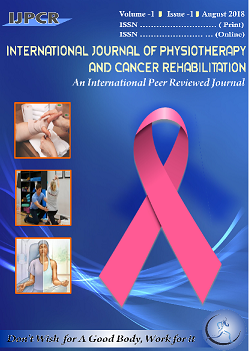International Journal of Physiotherapy and Cancer Rehabilitation
SEARCH
Our Founder
Popurlaly known as ‘jannu bhai’, the Late manishi’s vision, farsightedness and sacrifice have enabled us reach the stature we enjoy today More...Vice Chancellor's Message
It gives me immense pleasure to learn that the 1st volume of international journal of physiotherapy and cancer rehabilitation is being More...Cover Page Volume I Issue I
 .
.
IJPCR
Effect of high-velocity low amplitude thrust spinal manipulation alters segmental instability, pain intensity, and health-related quality of life among patients with chronic non-specific low back pain: A randomized control trial.
Prof. (Dr.) Jasobanta Sethi, MPT, PhD, FIAP Amity Institute of Physiotherapy, Amity University, UP, Noida-201313, India
Abstract:
Background: Chronic non-specific low back pain (NSCLBP) is the single largest, common, complex musculoskeletal condition in the world and it’s estimated that 80% of the population have experienced almost in every adult individual’s life. The purpose of this study was to investigate the effectiveness of spinal manipulation therapy- high-velocity low amplitude thrust (SMT-HVLA thrust) changes in pain intensity and segmental instability and quality of life in patients with CNSLBP.
Materials and Methods:
Randomized controlled trial conducted on 105 patients with CNSLBP (with duration of pain more than 3 months) distributed in three groups with 35 participants in each group and an average age of the participants was 25.66 (SD=6.74) years. Participants receiving the SMT-HVLA thrust with ergonomic advice (Study Group-1), core stability exercise with ergonomic advice (Study Group-2), and supervised exercise with ergonomic advice (Control Group) were assigned in three groups for intervention for 4 weeks. Primary outcomes were pain intensity measured by a 0 to 10 numeric pain rating scale and postural sway (center of foot pressure) measured by Win track Platform and quality of life measured by EuroQoL questionnaire at 2 weeks and 4 weeks. Univariate analysis of variance (ANOVA) with post-hoc Tukey's multiple comparison tests was carried out to examine treatment effects and the relationship between groups changes across outcome measures.
Results:
For all three treatment groups, outcomes checked after 2 weeks of treatment. Those who received spinal manipulation therapy with ergonomic advice had slightly better outcomes than the supervised exercise and advice group at 2 weeks (between-group difference, pain intensity (P=0.001), segmental instability (P=0.001) and quality of life (P=0.001) as compared to core stability exercise with ergonomic advice and supervised exercise and ergonomic advice group at 2 weeks (between-group difference, pain intensity (P=0.03), segmental instability (P=0.04) and quality of life (P=0.05) as well as at 4 weeks (between-group difference) in pain intensity (P=0.05), segmental instability (P=0.03), quality of life (P=0.04).
Results:
For all three treatment groups, outcomes checked after 2 weeks of treatment. Those who received spinal manipulation therapy with ergonomic advice had slightly better outcomes than the supervised exercise and advice group at 2 weeks (between-group difference, pain intensity (P=0.001), segmental instability (P=0.001) and quality of life (P=0.001) as compared to core stability exercise with ergonomic advice and supervised exercise and ergonomic advice group at 2 weeks (between-group difference, pain intensity (P=0.03), segmental instability (P=0.04) and quality of life (P=0.05) as well as at 4 weeks (between-group difference) in pain intensity (P=0.05), segmental instability (P=0.03), quality of life (P=0.04).
Keywords: High-velocity low amplitude thrust, core stability exercise, supervises exercise.